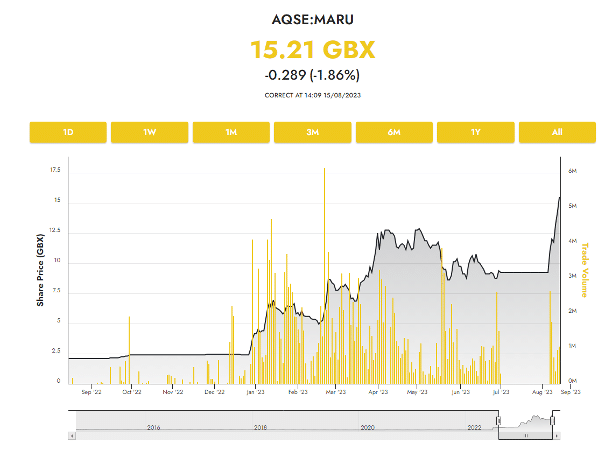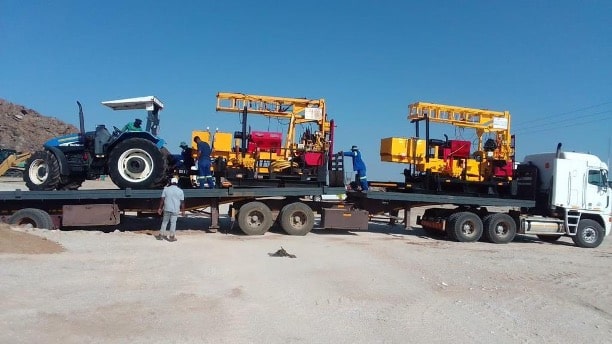In November 2002, I characterised MARU as perhaps the ‘best growth stock for 2023.’ How has that prediction panned out?

Nine months ago — or roughly the length of time it takes to grow a new person — I identified Marula as a top growth stock to watch. While I was particularly attracted to its Blesberg lithium asset, I was also actively seeking out graphite stocks, and the cross-asset and varied jurisdictional nature of the company’s assets made it an easy buy at 2.45p.
And it’s gone well so far.

One concern I did have — and still do have, to a degree — is that while multi-asset exploratory companies are lower risk, I view managing multiple assets simultaneously as very similar to walking dogs in a park. One is easy, two is manageable, and more than three requires a significant level of skill and hard work.
Fortunately, CEO Jason Brewer seems up to the task, in addition to his other responsibilities at Shuka (formerly Edenville) and NEO.
While I plan to conduct a full analysis at the one year anniversary, I think it worthwhile to quickly run through recent August developments at the flagship Blesberg Lithium Project. Longer-term, Blesberg may be usurped as the flagship — but right now, it’s driving the share price higher.
This piece isn’t going to cover the positive developments at other assets, as this value driver will be the key selling point as Marula finally gets going with its FTSE AIM IPO.
Ironically, I have in the past noted that all exploratory mining comes with delays — it seems that MARU’s delays will be administrative in nature given the final results delay and IPO setbacks. On a scale of problems these are pretty low, especially given increasingly complex regulatory requirements and a lack of auditors qualified to meet them. Outside of Marula, this will become more common.
As an aside, I will not be delving into final results, which are already out of date.
Back to the August developments:
Blesberg updates
Blesberg remains the flagship and lithium is still the early-2000s Britney Spears of the critical minerals industry. You had to be there.
On 7 August, assay results come in, whereby stockpile sampling and analysis of a 30 tonne batch sample by CI Group confirmed a high-grade spodumene product with a grade of 6.50% Li2O — more than enough to be of the hallowed SC6 grade.
This testing was conducted on current stockpiles at the site, and not to-be-mined ore — and MARU is also producing a <10mm fines product, and an intermediate product of +10mm to 50mm to be processed using an optical ore sorter during this half.
This now means that the delayed sales of +50mm spodumene product at the project can now be sold. Importantly, MARU noted that sales ‘will now proceed under new longer-term sales arrangements that the company is finalising with a new trading counterparty, with initial shipments of material to commence in due course.’
Brewer noted that ‘the results clearly confirm the high-grade nature of spodumene product… we are pleased to witness the growing interest from buyers for long-term offtake agreements and look forward to providing more information on the longer terms sales agreements currently under negotiation shortly.’
A day later the company announced that more equipment had arrived on site, secured for $540,000 through partner Q Global’s relationship with Bell Equipment, on standard hire purchase arrangements.
Then on 11 August, Marula announced a $1.35 million drilling and mine planning program, again funded by Q Global. Drilling contractors PDS Africa Pty Limited were appointed shortly thereafter, with the plan being to define ‘a maiden JORC resource for Blesberg and to be the basis of the initial hard rock open pit mining plan that is to be developed.’
Program Overview
Breaking this down into its key points:
The program is set to include a two-phase 2,900-meter diamond drilling effort spanning 38 holes, is currently in its advanced stages and is projected to conclude shortly. Following this, mobilisation to the site will be initiated, followed by the commencement of the drilling process. The program will be overseen by Mr. Jacques Perold, the company’s geological consultant, who has been appointed as the Project Manager.

Airborne Geophysics Study:
- Encompassing the Blesberg prospecting license and potential new license areas
- Aiming to conduct a survey over a total area of 1,200 km2
- Survey size: 539 line kilometres with a line spacing of 100m
Diamond Drilling Program:
- First phase: 20-hole, 1,500m diamond drilling program
- Drill spacing: 25m x 50m
- Second phase: 18-hole, 1,400m diamond drilling program
- Drill spacing: 25m x 25m
- Completion timeframe for both phases: 6 months
Trenching Program:
- Already initiated with an initial 5 trenches
Other key components to consider:
- Geological modelling
- JORC Code 2012 compliant resource statement and report
- Open pit mine design study
- Initial mining works program
- Slope stability, groundwater, and geohydrology studies
- Environmental management studies
- Discounted cashflow analyses
- Competent person reports

First Phase Drilling Program:
- Aims to establish a maiden JORC Code 2012 compliant Mineral Resource Estimate (“MRE”)
- Supports the initial hard rock open pit mining plan
- Will consist of a 20-hole, 1,500m diamond drilling program
- Intended to be conducted on a 25m x 50m drill spacing
Second Phase Drilling Program:
- Targets enhancing the confidence level of the MRE
- Aims to further expand and confirm the extent of mineralization
- Supports broader mine development plans for Blesberg
- Encompasses an 18-hole, 1,400m diamond drilling program
- Planned drill spacing: 25m x 25m
Brewer considers that ‘activities at the Blesberg Lithium and Tantalum Mine are moving ahead at pace. Whilst we are continuing to progress the mining and processing of the high-grade spodumene and lithium mineralisation in the historic stockpiles, we are now also moving ahead with a resource drilling exploration and mining program…This study work will give us an indication of the opportunity that I believe Blesberg presents to Marula and to shareholders.’
There are now two key considerations for long-term investors; first is the results of this Blesberg program. While the asset is clearly very promising given the presence of SC6 — especially given the financial vote of confidence — there are no guarantees until results are interpreted and RNS’d several months from now. One of the advantages with MARU is that a poor result, though unlikely, would not be a disaster as it has more than one promising asset to its name.
The second is financing — at some point, Marula may need to get more cash for long-term business development. A combination of offtake agreements and Q Global money may well be enough over the shorter-term, but I suspect that the company has ambitions that will involve larger investment.
When the FTSE AIM IPO launches, I will cover the story to date in depth.
This article has been prepared for information purposes only by Charles Archer. It does not constitute advice, and no party accepts any liability for either accuracy or for investing decisions made using the information provided.
Further, it is not intended for distribution to, or use by, any person in any country or jurisdiction where such distribution or use would be contrary to local law or regulation.